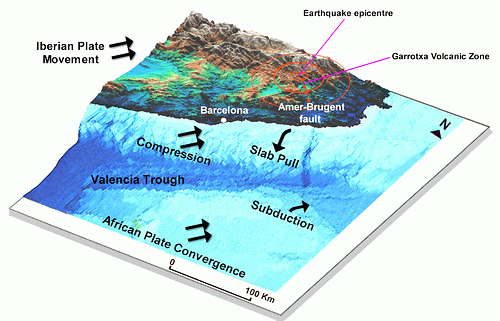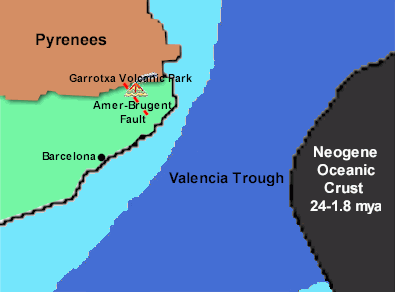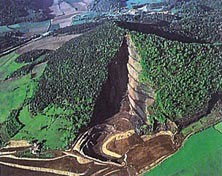Barcelona: Earthquakes and Volcanoes
The earthquake and volcanic activity of the Barcelona region is largely the result of convergence between the Eurasian and African plates, with the Iberian micro plate caught between the two and absorbing much of the impact. The geology is diverse and complex, defying easy tectonic generalizations.
The direction of the relative motion between Africa and Europe is still under debate. Most reconstructions show directions of relative motion between north-west and north-east. Recent space geodesy data confirm this overall trend, in which Africa has a north-south component of convergence relative to Europe of about 5 mm year, but they also show that the absolute plate-motion directions of both Europe and Africa are north-east and not north or north-west as is usually assumed (see the NASA database on present global plate motions).
 |
| Simplified diagram showing the estimated
positions and movement of the plates in the Western Mediterranean. Click
for geodesy data. |
The western Mediterranean region is characterised by a moderate and diffuse seismic activity that is in accordance with the relatively slow convergence rate. Although this deformation must be distributed between the African and European margins, it seems that a great part of this convergence is absorbed in the Pyrenees and the Alps, and could be concentrated on singular structures (mainly NW-SE and E-W fault lines in the Eastern Pyrenees).
The diagram below indicates how stretching and thinning of the crust by tectonic activity may have opened the Amer-Brugent fault system which seems to be the focus of recent earthquakes as well as the alkaline volcanism of the Garrotxa region (Lewis et al. 1998). Croscat, the youngest volcano in the area recorded two eruptions which took place 17,000 and 11,500 years ago.

Topography of NE Spain showing estimated plate movements and
possible tectonic processes at work. Bathymetry is approximate.
|
|||||||
The Amer-Brugent fault system has well defined evidence of recent activity
(Armijo et al., 1988). An important earthquake occurred along the fault line in
1428 at Queralbs with a maximum intensity of 9 on the Richter Scale. The
Queralbs epicentre is shown on the above diagram.
Present day seismicity is more moderate, in agreement with the low deformation rate of the region. A more recent earthquake, also centred on Queralbs, occurred on 21 September 2004 and registered 4.2 on the Richter scale. An earthquake of this magnitude can be expected to occur in the region two or three times in a decade. It was felt throughout the city of Barcelona, probably because, like the 1428 earthquake, its focus was shallow (between 2 and 4 kilometres). Shallow-focus earthquakes tend to be larger and more damaging. This is because they are closer to the surface where the rocks are stronger and build up more strain energy.
The geology of Barcelona's site (mainly quaternary sands) helps to accentuate an earthquake's effects. In most cases, shaking on sand is greater than shaking on rock. In some situations a resonance can occur in deep sand layers, markedly amplifying the shaking at certain frequencies. Liquefaction can occur if shaking causes the transformation of loosely packed, water-saturated sand, into a fluid mass. The sediments thus lose their strength and can no longer support buildings which may then sink or lean.
The SERGISAI project has made a GIS-based evaluation of earthquake hazard and risk scenarios for the Barcelona urban area.
It is interesting to note that just before Barcelona was shaken by the September 21 2004 earthquake, a 4.7 earthquake on the adjoining Eurasian plate led to buildings in Kaliningrad on the Russian border with Poland being evacuated. Geologists say that in this case, the tremors were caused by the rising of the Scandinavian plateau, still recovering from the heavy ice sheet that covered the region in the last Ice Age. The two earth tremors may be connected since movements in one plate create new stresses elsewhere. Should Barcelona's seismic risk be adjusted in the light of today's melting ice caps?
Key Mediterranean Tectonics Research Sources:
2. Mediterranean
Tectonics: Carminati E. & Doglioni C. (2004)


